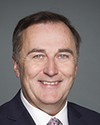Thank you for inviting me to speak before the committee today. I'm sorry I can't be there.
I represent the Canadian Olympic Committee, and I'm the chief medical officer or head physician for our Canadian Olympic team.
In my role in high performance sport over the last three decades, I've had the privilege of working at many multi-sport events, such as the Olympics and the Pan American Games, and I've been the head physician for several of our senior national teams, many of which are at high risk for concussion. I also act as the lead physician for the B.C. Lions in the Canadian Football League and work with the Vancouver Whitecaps in the MLS. I've had exposure to this problem of sport concussion, and in addition to working in the trenches, I've also been involved in sport safety from the policy perspective. I sit on the health and safety advisory board for the CFL, and I'm on the medical commission for Panam Sports, the group that determines health policy for North America and South America at the Pan American Games.
Getting back to my role with the Canadian Olympic Committee, as the chief medical officer, I'm the lead for health policy. At the COC, the health of our athletes is our top priority, and we're proud of that.
Concussions have been a focus of ours for years, and we recently completed an extensive collaboration with the medical leagues from the Canadian Olympic and Paralympic Sport Institute, Own the Podium and the Canadian Paralympic Committee. From this we announced some sport-related concussion guidelines designed to protect our senior national team athletes and next-gen athletes in high-risk sports. Again, we focused on that high performance group that are also at high risk for concussions.
We take pride in this because this is one of the first efforts where we've been able to standardize our approach across the country. That's taken a lot of work, as you might imagine, but we think it's a positive step forward for the sport and medicine community. They're consistent with the international consensus documents from Berlin that I'm sure you've heard about, and we've coordinated with Parachute Canada.
There are some unique features of our high performance system that allow us to deliver some unique services. These include that during pre-season, prior to the first game of training camp, we recommend that all high-risk athletes complete a battery of clinical assessments and neuropsychological tests under the guidance of the team physician. This is beyond what Parachute recommends for sport-related concussion. For high-risk sports, and again, this is the high performance pool, we recommend that a certified athletic therapist, physiotherapist, chiropractor or physician be at all training sessions and competitions.
If a concussion is suspected, of course the player is immediately removed from training or competition, and they are to be assessed by a member of the health team in a distraction-free environment. Sometimes a diagnosis of a concussion can be challenging, and it needs somebody with experience and expertise to be able to make the decision whether it's safe to return to that session, whether it be competition or training.
Post-concussion, if the athlete is determined by the medical team to be free of symptoms at rest and with exertion, we suggest that the athlete be tested again with neuropsychological tests so we can compare the results to their individual baseline. We can do this because we have a network of experts who have been involved in sports medicine, and the interpretation and results of these tests takes training and experience.
The last thing is that the guidelines lay out recommendations for when the athletes can return to sport. There are four. There has to be resolution of symptoms at rest. There has to be no recurrence of symptoms when they are doing exercise at the levels required for competition and training. The athletes have to have those neuropsychological tests repeated to make sure they're back to baseline. Finally, the athletes have to have further education on the risks of premature return to sport and the risks of repeated concussion, and they have to sign a consent to that effect. These guidelines will be in place prior to the Olympic and Paralympic Games in 2020 in Tokyo, and will also be used at the Pan Am Games in Lima, Peru, this summer.
However, it's important to recognize that this is an evolving area with ongoing research. There's much more that needs to be done. This requires support.
I know that the committee has heard this before. I say that we wholeheartedly support funding research. Having said that, we can be proud of the fact that Canadians have been real leaders in knowledge development and in translation when it comes to sport-related concussion.
Because things are evolving rather quickly, the high performance guidelines referred to will be reviewed annually to make sure that they are kept up to date.
I've been in this for a fairly long time. This issue of sport-related concussions has actually come a long way. While there's work to do, we have made a lot of progress, including rule changes in almost all high-risk sports, enhanced equipment and better education of athletes, support staff, coaches, family and the general public. We've also worked to change the culture that has glorified the hellacious hit. I believe all these measures have led to improved diagnosis, treatment and most importantly, prevention.
On a different note, although we as health professionals prioritize health care, we have to recognize that we'll never have risk-free sport. While we want to make it as safe as possible, we have to be careful not to magnify the problem of sport concussion to the point where we reduce the level of physical activity in Canadians. The greatest health risks we face as a society relate to obesity, type 2 diabetes, cardiovascular disease and a host of other major medical issues that are related to inactivity. Exercise is medicine. We need to promote active lifestyles with options for everyone.
In closing, thank you again for having me. The very existence of this committee speaks to the importance of this and the need for discussion and dialogue. At the COC, we're proud that we're prioritizing our athletes' health and we've taken steps to develop a consensus that can be applied across the country and when we go to games. It's a collaborative effort that will continue. It must continue.
Thanks again for your attention. I welcome any questions.



